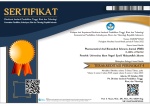Analisis Senyawa Asam Mefenamat dalam Sediaan Jamu Pegal Linu di PasarSumber Kabupaten Cirebon
Abstract
Abstract: Indonesia is a country where people are still productive in consuming herbal medicine. The number of consumers of herbal medicine resulted in some herbal medicine manufacturers adding medicinal chemicals in it. In accordance with BPOM rules that apply a herbal medicine may not contain the slightest BKO. This study aim to analyze the content of mefenamic acid in herbs that circulate around the Sumber Regency market in Cirebon. Mefenamic acid is one of the drugs used to treat various kinds of pain, especially toothache, muscle aches, joint pains and aches when or before menstruation. The method used in this research is descriptive qualitative test using Thin Layer Chromatography (TLC) and quantitative tests using UV-Vis spectrophotometry. In TLC, the initial identification of a compound is based on a comparison of the value of Rf versus standard Rf. Rf values are generally not the same from laboratory to laboratory even at different analysis times in the same laboratory, so it is necessary to consider the use of relative Rf, ie the Rf value of compound stains compared to other compound stains on the same plate. Five of the eight samples found on the market contained mefenamic acid compounds. The samples containing mefenamic acid of found in the code numbers B, C, F, G and H. The highest levels of mefenamic acid were found in the B-1 sample of 0.14%. According to the One Way ANOVA statistical test results obtained a sig value of 0.001 <0.05. This shows the data on the levels of mefenamic acid in a sample of aching rheumatic / rheumatic herbs there are significant differences circulating in the Sumber Regency Cirebon market.
DOI: 10.15408/pbsj.v4i2.27812






